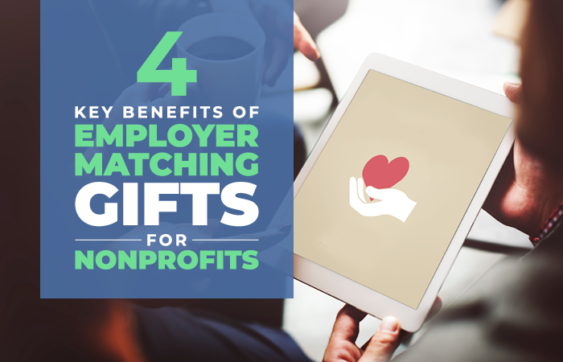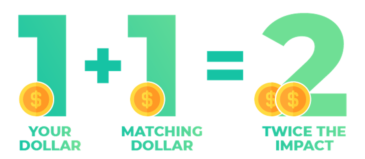4 Key Benefits of Employer Matching Gifts for Nonprofits

Employer matching gifts offer ample benefits to each stakeholder, including the company matching the gift, the employee making the initial donation, and the nonprofit receiving the funds.
For the companies, they get to maximize employee engagement, increase their reputation among consumers, and help meet critical community needs. For the employees, they get to support the causes they care about while knowing their donation is making double the impact.
One might argue, however, that the nonprofit is the party that benefits the most from these types of corporate giving programs—and that’s what we’ll focus on in this quick guide. Some of the most notable advantages to nonprofits from employer matching gifts include:
- Added fundraising revenue
- Increased supporter engagement
- Improved donor retention
- New and long-term business relations
Before diving into the benefits, it’s important to recap the basics of these matching gifts in the first place. Employer or corporate matching gift programs are a popular form of corporate philanthropy in which a company matches donations made by employees to eligible nonprofit causes. This essentially provides nonprofits with free donations to boost existing fundraising revenue and better pursue their missions while crafting stronger, lifelong bonds with their donors.
Ready to find out more about how matching gifts make an impact? Let’s get started.
1. Added Fundraising Revenue
One of the most obvious benefits of employer matching gifts on nonprofit fundraising is the additional revenue collected through the matches. According to these statistics from Double the Donation, 91% of companies match donations at a dollar for dollar ratio, while 5% match at even higher levels such as 2 or 3:1.

Additionally, 84% of surveyed supporters reported a higher likelihood of giving if they know a corporate match is being applied, while 1 in 3 donors indicated that they’d give a larger gift if it will be matched.
So what does that mean for your nonprofit fundraising? Imagine the following scenarios:
- A donor makes a gift of $1,000 to your organization. Then, they request a match from their employer who happens to match at a 3:1 ratio. That means the employer makes their donation of $3,000 in addition to the donor’s initial contribution of $1,000—bringing the total to $4,000!
- A second donor is on the fence about whether they’d like to make a donation. When they determine that their employer will match the donation should they make it, it’s exactly the push they need to submit the gift.
- A third donor recognizes that their gift is eligible for a corporate match from their employer and decides to up their initial contribution by $100 to make an even greater impact.
What do all of these examples have in common? Your organization receives more generous donor funding than you otherwise would have without a matching gift strategy in place.
2. Increased Supporter Engagement
Engaging with your supporters is critical for building long-term relationships and ensuring they remain fulfilled and empowered throughout the donation lifecycle. Consider the following key matching-gift-related engagement strategies:
- Incorporating matching gifts in your online donation form: Your online donation form is already the point where donors are most engaged in your organization. It makes sense to include matching gifts in the process to drive engagement levels even higher. For example, you’re less likely to lose donors to “shopping cart abandonment” when they’re informed that their donation is match-eligible.
- Sending a follow-up matching gift message: For donors who opt not to complete the matching gift request process during the donation itself, it’s a good idea to send out personalized outreach following the gift. This can be in the form of an automated confirmation, thank-you email, or a piece of direct mail. Regardless of the channel you choose, this added communication is great for strengthening your donor relationships.
- Leveraging targeted donor communications: Employing matching gift outreach is a great way to leverage strategic donor segmentation practices. The more targeted your messaging, the more likely donors are to respond positively and follow through with the intended action—in this case, requesting a corporate match for their donation.
Promoting matching gifts as an additional engagement opportunity is a great idea because it allows donors to do more for your cause without having to reach back into their own wallets. This is crucial because, for an optimal donor relations strategy, it’s important that not every communication is a financial ask.
3. Improved Donor Retention
Matching gifts allow donors to make a larger impact on a nonprofit that they care about. Because this leads supporters to feel more like valued partners in your organization, it’s a great way to improve the donor journey and keep them coming back time and time again.
Specifically, matching gifts allow you to:
- Keep your mission at top of mind.
- Provide additional touch points with your organization.
- Communicate greater donor impact.
These benefits and more allow you to improve your donor stewardship strategies and increase retention levels significantly. And remember, it’s much more cost-effective to retain an existing donor than it is to be constantly on the lookout for new, one-time supporters.
4. New and Long-Term Business Relations
Nonprofit-corporate partnerships offer unique and exclusive opportunities for charitable organizations to form long-term relationships with businesses interested in supporting them. But did you know that this type of partnership can be born from a matching gift?
As you begin exploring the world of corporate giving, browsing lists of top matching gift companies can give you a better sense of the types of philanthropic-minded businesses in your network. Take a look at the following examples:
- General Electric: GE created the first known matching gift program in 1954 which has continued to grow since then. Now, the company matches more than $35 million in charitable donations each year.
- Microsoft: Microsoft has donated more than $1 billion since rolling out their matching gift program, with more than $47 million in the last year alone. They’re also known for heavily promoting employee giving programs internally, resulting in more than 65% employee participation.
- Soros Fund Management: This company has an extremely generous matching gift program with a match ratio of up to 3:1 and a maximum match at $300,000—currently the highest limit for any corporation.
If you notice existing donors are employed by these or other companies with generous corporate giving programs, that can be a great place to launch your business relations efforts. Plus, you can be sure to highlight CSR and cause marketing benefits to corporations you’re seeking partnerships with.
Making the most of powerful employee giving programs is critical for nonprofits looking to effectively leverage available resources. In fact, our studies show that an average of $4 to $7 billion in matching gift revenue is left on the table by eligible donors each year.
When you take a strategic approach to matching gift fundraising, you can start to collect those unclaimed dollars to put toward your mission. Good luck, and happy fundraising!
About Double the Donation: Automate your matching gift fundraising with the industry-leading solution from Double the Donation. The 360MatchPro platform provides nonprofits with tools to identify match-eligible donors, drive matches to completion, and gain actionable insights. 360MatchPro integrates directly into donation forms, CRMs, social fundraising software, and other nonprofit technology solutions to capture employment information and follow up appropriately with donors about matching gifts.



